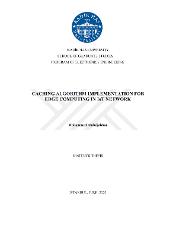| dc.contributor.advisor | Özmen, Atilla | en_US |
| dc.contributor.advisor | Öğrenci, Arif Selçuk | en_US |
| dc.contributor.author | Abduljabbar, Mohammed | |
| dc.date.accessioned | 2021-02-13T10:07:18Z | |
| dc.date.available | 2021-02-13T10:07:18Z | |
| dc.date.issued | 2020 | |
| dc.identifier.uri | https://hdl.handle.net/20.500.12469/3900 | |
| dc.description.abstract | The developing IoT concept brings new challenges to the service providers. The architecture of the networks changes to satisfy the needs arising by the large number of connected devices. Edge computing is the new architectural solution that will be used in the IoT networks. This architecture is more dynamic than the cloud computing network where the data can be quickly processed in the different layers of the network without going to the cloud. This will remove the problems faced by cloud computing: increase in data traffic and increase in latency of provided services. Research on edge computing in IoT networks encompass information-centric networks, use of 5G, and improving the hardware devices however a suitable solution for all the IoT use cases is not available yet. In this thesis, use of caching among IoT nodes is proposed as a solution to increase the efficiency of edge computing. Caching is an old but effective solution for dealing with data because it improves the real-time response of the system and can be used in IoT use cases. It will also not cause an extra hardware cost. In this research, two commonly used caching algorithms, LRU (Least Recently Used) and FIFO (First in First Out), are investigated and compared for their performance in sample IoT scenarios. Reductions in data processing time are observed where CPU and RAM utilizations are enhanced. | en_US |
| dc.description.abstract | Gelişen IoT kavramı bu alandaki hizmet sağlayıcılarına başetmeleri gereken yeni sorunlar ortaya çıkarmaktadır. Ağ mimarileri, bağlı bulunan yoğun cihazların değişen ihtiyaçlarını karşılamak için değişmektedir ve çözüm olarak da "kenarda hesaplama" IoT ağlarında ortaya çıkan yeni mimari yaklaşımdır. Bu mimari bulutta hesaplamaya göre daha dinamiktir çünkü ağın her bir katmanında veri işlemeye olanak sağlamaktadır. Bu sayede bulutta hesaplamanın yarattığı iki soruna çare olmaktadır: veri trafiğinde artış ve sağlanan hizmetlerdeki gecikme. IoT ağlarında kenarda hesaplama konusunda yapılan araştırmalar enformasyon merkezli ağları, 5G kullanımını ve donanım cihazlarında iyileştirmeler gibi konuları da kapsamaktadır. Ancak hala tüm IoT kullanım alanları için uygun çözümler ortaya çıkmamıştır. Bu tezde, kenarda hesaplamada verimi artırmak için IoT düğümlerinde önbellekleme kullanımı önerilmektedir. Önbellekleme eski ama etkin bir veri işleme yöntemidir, sistemlerin gerçek zamanlı cevap süresini iyileştirmektetir ve IoT kullanım alanlarında uygulanabilir bir yöntemdir. Ayrı bir donanım maliyeti getirmemesi de bir avantajdır. Bu araştırmada, sık kullanılan iki önbellekleme algoritması (LRU ve FIFO) incelenmiş ve örnek IoT senaryolarında başarımları kıyaslanmıştır. İşlemci ve hafıza kullanımı iyileşirken, işlem sürelerinin azaldığı gözlenmiştir. | en_US] |
| dc.language.iso | eng | en_US |
| dc.publisher | Kadir Has Üniversitesi | en_US |
| dc.rights | info:eu-repo/semantics/openAccess | en_US |
| dc.subject | Electricity history | en_US |
| dc.subject | Elektrik tarihi | en_US |
| dc.title | Caching algorithm implementation for edge computing in IoT network | en_US |
| dc.type | masterThesis | en_US |
| dc.department | Enstitüler, Lisansüstü Eğitim Enstitüsü, Elektronik Mühendisliği Ana Bilim Dalı | en_US |
| dc.institutionauthor | Abduljabbar, Mohammed | en_US |
| dc.relation.publicationcategory | Tez | en_US |
| dc.identifier.yoktezid | 650204 | en_US |
















